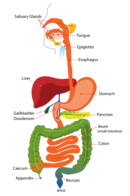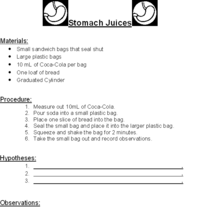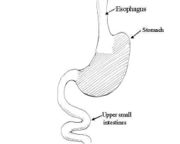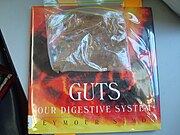Stomach Juices
| Instant wiki maker | Making handouts | Editing tips |
Biology In Elementary Schools is a Saint Michael's College student project from a course that ran between 2007 and 2010 and fully described in this book chapter. The student-created resources have been preserved here for posterity. Link under 'toolbox' for printer-friendly versions of the exercises. Click on handouts to print full resolution versions. Please see Wikieducator's disclaimer, our safety statement, and the Creative Commons licensing in English and in legalese.
Student worthiness
This experiment has been tested and proven to work! Kids love it!
Primary biological content area covered
This experiment will address the topic of the stomach and digestion. The bread represents the food in the stomach, while the soda represents the acid that is present in the stomach. In order for food to be digested in the body, the food is mixed with acidic juices in the stomach. The process begins in the mouth when the food is chewed, then travels down the the digestive tract. Food is broken down as it travels, and eventually moves to the small intestine where the process if finished.
Materials
- Ziploc bags
- Soda
- Loaf of bread
- Graduated cylinder
- pH strips
Handouts
This is the handout that will be given to the students before beginning the experiment:
Description of activity
Each student will be given a ziploc bag and a piece of bread. Students will each hold open the ziploc bag, which represents the stomach, a muscle that squeezes the food. Student will also be given a small amount of soda, which will be poured into the bag and will represent the stomach juices. Next a piece of bread will be added to the bag and students will squeeze the bag for about a minute. The bread will turn to liquid representing the food becoming ready to be absorbed into the small intestine and into the blood stream.
Lesson plan
- To introduce the subject, read the book Guts: Our Digestive System, by Simon, Seymour
- Then pass out a ziploc bag, a piece of bread, and a small amount of soda to each student
- Place the piece of bread in the bag
- Have each student measure 65 mL of soda in a graduated cylinder and measure the pH
- Pour the soda into the bag and seal the bag tightly, making sure as much air as possible is out of the bag. As a precaution, you may want to double-bag it to avoid leaking.
- The students then squeeze the bag for about a minute
- After one minute, the bread will have dissolved in the soda. Ask the students why they think this happened and explain how the stomach works to digest food
- BagofBreadsmc.jpg
Bag before Squishing
Potential pitfalls
As with any experiment that is conducted in a classroom, there are potential pitfalls. There is always the danger of a large mess with overzealous shaking. When closing the ziploc bag, be sure that the seal is tight and won't open when the students are squeezing it, preventing explotions and unwanted mess. Also, make sure that all the air is out of the bag so there is an accurate representation of the stomach. This will also lower the chances for bag opening.
Math connections
Lessons that incorporate several fields of study are ideal. In this experiment, the students will be measuring the volume of soda that will be poured into each bag. Students will be using a graduated cylinder to measure out 65mL of soda. Measuring volume is a great way for students to use their mathematics skills to ensure that the correct amount of soda is poured into each bag. Students will also be comparing the pH of several liquids that are consumed daily. Students will be incorporating mathematics to compare the different pH levels.
Literature connections
It is important for children to have an understanding of the digestive system; the stomach in particular. One way for children to gain background knowledge is to read about the stomach. Students that are looking for a more in depth look in the rest of the digestive system, including organs including and going beyong the stomach, will benefit from reading outside texts. One text that is biologically accurate and entertaining for young children is:
- Simon, Seymour. (2005). Guts: our digestive system. New York, NY: Harper Collins.
Connections to educational standards
Vermont Educational Standards
7.14 Students demonstrate understanding of the human body — heredity, body systems, and individual development — and understand the impact of the environment on the human body.
Next steps
The next steps following this activity are to continue to learn about the digestive system by following the food which has been digested in the stomach into the small intestine and blood stream.
Reflections
We think that this experiment went really well. It seemed as though the students had a lot of fun simulating the job of the stomach. They enjoyed the book that we read to them in the beginning, and it got them excited about the experiment. The students seemed to know a little bit about the stomach, and they were excited to tell us what they knew. When we simulated how the stomach worked, the students thought that it was very fun. They enjoyed pretending to be the muscles, breaking down the food in the simulated stomach. It gave them a good visual to help them understand the stomach. Overall, the experiment went really well with the students. They learned a great deal, and it seemed that they enjoyed it.
- Stomach Juices was my favorite lesson to teach throughout the entire semester. The vivid nature of the bread being mashed in the bag was disgusting, and very similar to the actual process. Although from a teacher's perspective the process was disgusting the students loved everything about it. It is definitely very important to make sure to seal the bags tightly and to ask the students to refrain from wailing on the bags. Aside from those two points it is a great experiment which when described with a vivid book the students love. -Maren
Citations and links
This idea was developed from ideas at http://www.proteacher.org/c/391_Digestive_System.html [1]








